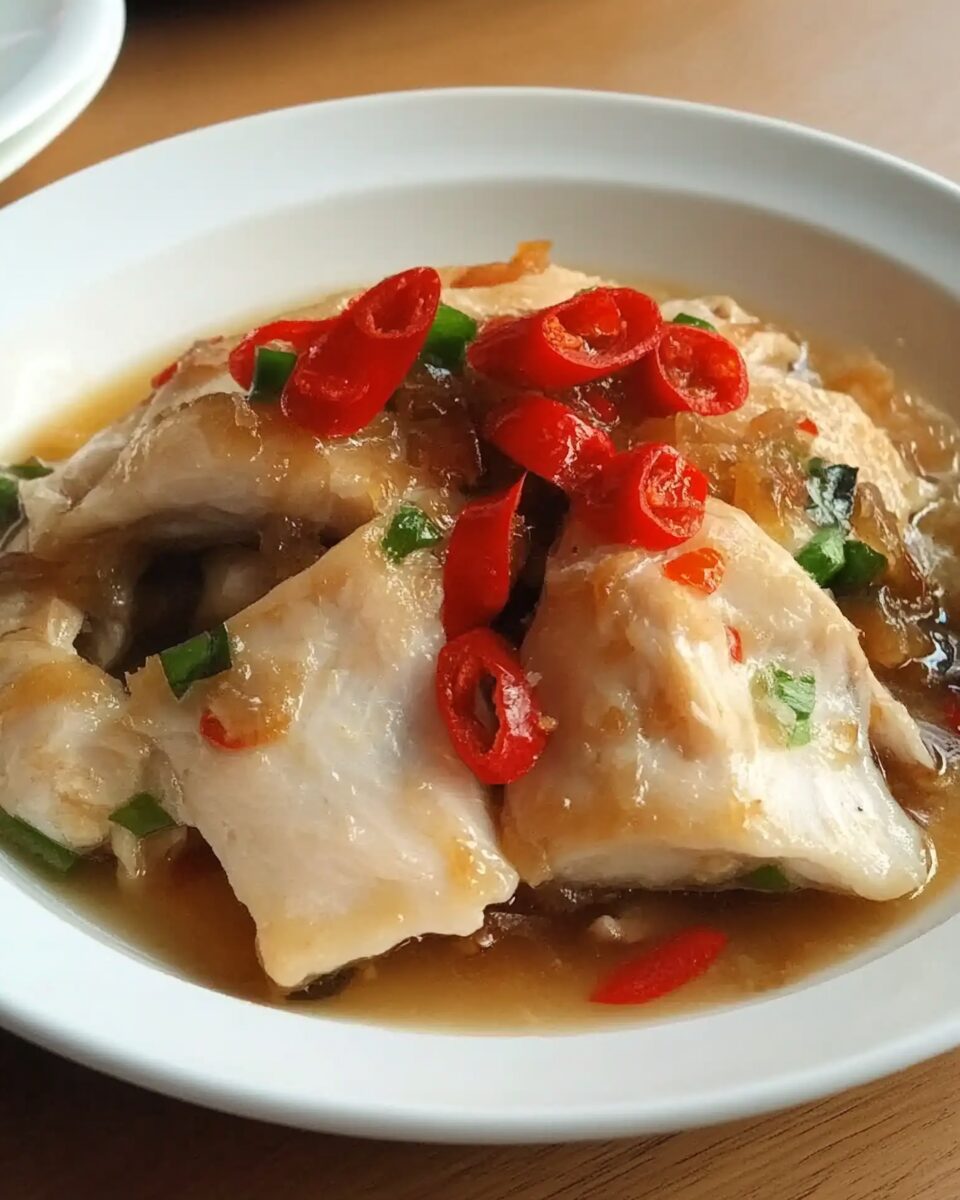Florn’s Chinese Steamed Fish is a delicate, fragrant dish that pairs perfectly with steamed rice. The tender snapper fillets are seasoned with fresh ginger, soy sauce, and sesame oil, then topped with shiitake mushrooms, tomatoes, and a touch of chili for a hint of spice. This quick and healthy recipe brings authentic Chinese flavors to your dinner table in under 30 minutes.
Full Recipe:
Ingredients:
- 1 pound red snapper fillets
- ½ teaspoon salt
- ½ teaspoon ground black pepper
- 1 tablespoon grated fresh ginger
- 1 tablespoon soy sauce
- 2 teaspoons sesame oil
- 2 shiitake mushrooms, thinly sliced
- 1 tomato, quartered
- ½ fresh red chili pepper, seeded and chopped
- 2 sprigs cilantro, finely chopped
Directions:
- Bring about 1 ½ inches of water to a boil in a steamer fitted with a basket large enough for the snapper to lie flat.
- Season the snapper fillets with salt and pepper, then place them in the steamer basket.
- Top the fish with grated ginger and drizzle with soy sauce and sesame oil.
- Add the sliced shiitake mushrooms, quartered tomato, and chopped red chili pepper to the steamer basket alongside the fish.
- Cover and steam for 15 minutes, or until the fish flakes easily with a fork.
- Sprinkle the steamed fish with freshly chopped cilantro and serve hot with rice.
Nutritional Facts:
Servings: 2
- Calories: 300 kcal
- Protein: 48 g
- Total Fat: 8 g
- Saturated Fat: 1 g
- Carbohydrates: 6 g
- Sugars: 3 g
- Fiber: 1 g
- Cholesterol: 84 mg
- Sodium: 1187 mg
- Potassium: 1177 mg
- Vitamin C: 29 mg (32% DV)
- Calcium: 87 mg (7% DV)
- Iron: 1 mg (7% DV)
Nutritional Facts:
- Calories: 300 kcal
- Protein: 48 g
- Total Fat: 8 g
- Saturated Fat: 1 g
- Cholesterol: 84 mg
- Sodium: 1187 mg
- Total Carbohydrates: 6 g
- Sugars: 3 g
- Dietary Fiber: 1 g
- Potassium: 1177 mg
- Vitamin C: 29 mg (32% DV)
- Calcium: 87 mg (7% DV)
- Iron: 1 mg (7% DV)
The Origins and Significance of Chinese Steamed Fish
Chinese steamed fish is a dish deeply rooted in Chinese culinary traditions, symbolizing prosperity, purity, and freshness. This delicacy is often a centerpiece during celebrations like Lunar New Year, weddings, and other festive gatherings, signifying abundance and good fortune. The fish’s delicate texture and light seasoning showcase the core principles of Chinese cuisine, which emphasize freshness and balance rather than overpowering flavors.
Traditionally, whole fish is used for this dish, as its presentation signifies unity and completeness. The practice of steaming fish dates back centuries, as it was a preferred cooking method to preserve the fish’s natural flavors while maintaining its tender, flaky texture.
Why Steaming is the Best Method for Cooking Fish
Steaming is a gentle cooking method that enhances the natural flavor of fish without masking its delicate taste. Unlike frying or grilling, steaming retains the fish’s moisture, ensuring a succulent and tender texture. This technique also allows the fish to absorb the subtle flavors of the aromatics and sauces used in preparation, such as ginger, scallions, soy sauce, and sesame oil.
Moreover, steaming is a healthy cooking method as it uses minimal oil and avoids the formation of harmful compounds that can occur during high-heat cooking methods like frying. This makes Chinese steamed fish an excellent choice for those seeking a nutritious and flavorful dish.
The Importance of Freshness in Chinese Steamed Fish
One of the key factors in achieving a perfect steamed fish is selecting the freshest fish possible. In Chinese cuisine, freshness is paramount, as the natural flavors of the fish are the star of the dish. Fresh fish should have bright, clear eyes, shiny scales, and a clean, ocean-like smell. Whole fish is preferred for steaming because it cooks evenly, and the bones add depth to the flavor.
Choosing the right type of fish is also essential. Mild, white-fleshed fish like sea bass, tilapia, or snapper are ideal for steaming as they have a delicate flavor that pairs well with the light and aromatic seasonings used in this dish.
Flavor Profile of Chinese Steamed Fish
The flavor of Chinese steamed fish is a harmonious blend of savory, umami, and slightly sweet notes. Aromatics like ginger and scallions are essential components, providing a fragrant and slightly spicy undertone that complements the fish’s natural sweetness. The soy sauce adds a rich umami depth, while a drizzle of sesame oil enhances the dish with its nutty aroma.
One of the unique aspects of this recipe is the balance between simplicity and sophistication. The ingredients are minimal, yet the dish delivers a complex and refined flavor profile. The key lies in the precise combination of fresh fish, aromatic seasonings, and the gentle cooking technique.
Cultural Variations in Chinese Steamed Fish
While the basic recipe for Chinese steamed fish remains consistent across regions, there are some variations that reflect local tastes and traditions. For example, in Cantonese cuisine, the fish is often served with a generous amount of hot oil poured over it after steaming, which lightly cooks the aromatics and enhances the dish’s fragrance. In Sichuan cuisine, chili oil or fermented black beans may be added for a spicy twist.
These regional variations showcase the adaptability of Chinese steamed fish while maintaining its core principles of freshness and simplicity.
Tips for Making the Perfect Steamed Fish
- Choose the Right Fish: Opt for fresh, whole fish with a mild flavor. Sea bass, tilapia, or snapper are excellent choices.
- Prep the Fish Properly: Clean the fish thoroughly, and make shallow cuts on the sides to allow the seasonings to penetrate.
- Use Fresh Aromatics: Ginger, scallions, and cilantro are essential for adding fragrance and flavor. Always use fresh ingredients for the best results.
- Steam Gently: Overcooking can result in dry, tough fish. Steam the fish just until it flakes easily with a fork.
- Finish with Sauce and Oil: A final drizzle of hot oil and a splash of soy sauce elevate the dish, adding richness and depth of flavor.
Health Benefits of Chinese Steamed Fish
Chinese steamed fish is not only delicious but also highly nutritious. Fish is an excellent source of lean protein, omega-3 fatty acids, and essential vitamins and minerals like vitamin D and selenium. The cooking method further enhances its health benefits, as steaming preserves the fish’s nutrients without adding unnecessary fats or calories. The use of aromatics like ginger and scallions also adds anti-inflammatory and digestive benefits, making this dish a wholesome choice for any meal.
Pairing Chinese Steamed Fish with Other Dishes
Chinese steamed fish pairs beautifully with a variety of side dishes, making it a versatile addition to any meal. For a traditional Chinese feast, serve it alongside steamed rice, stir-fried vegetables, or noodle dishes. Light soups or a simple vegetable medley can also complement the dish without overpowering its delicate flavors.
For a modern twist, consider pairing the steamed fish with a crisp white wine or sparkling water infused with citrus. These accompaniments enhance the freshness of the dish, creating a well-rounded and satisfying dining experience.
Why You Should Try Making Chinese Steamed Fish at Home
Preparing Chinese steamed fish at home allows you to experience authentic Chinese flavors in a simple and healthy way. Despite its elegant presentation, the dish is surprisingly easy to make, requiring minimal ingredients and effort. It’s a fantastic option for family dinners, special occasions, or when you want to impress guests with your culinary skills.
Moreover, making this dish at home gives you the freedom to experiment with flavors and tailor the recipe to your preferences. Whether you stick to the classic preparation or add your own creative twist, Chinese steamed fish is sure to become a favorite in your recipe repertoire.
Conclusion
Chinese steamed fish is a testament to the beauty of simplicity in cooking. Its rich cultural heritage, emphasis on freshness, and balanced flavors make it a dish that transcends time and trends. Whether you’re new to Chinese cuisine or a seasoned enthusiast, this dish offers a unique and satisfying experience that celebrates the essence of traditional cooking.






